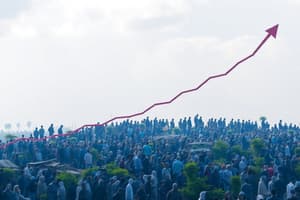Podcast
Questions and Answers
What is the age distribution characteristic of countries with rapid growth?
What is the age distribution characteristic of countries with rapid growth?
- High proportion of reproductive individuals
- High proportion of post-reproductive individuals
- High proportion of pre-reproductive individuals (correct)
- Equal distribution among all age groups
Countries with low fertility rates tend to have younger populations.
Countries with low fertility rates tend to have younger populations.
False (B)
Name one country that demonstrates a no growth age structure.
Name one country that demonstrates a no growth age structure.
Japan
Countries with advanced healthcare tend to have ______ populations.
Countries with advanced healthcare tend to have ______ populations.
Match the following age structures with their characteristics:
Match the following age structures with their characteristics:
How does economic development influence age distribution?
How does economic development influence age distribution?
What effect does migration have on age distribution?
What effect does migration have on age distribution?
A slow growth age structure produces enough children to replace the population.
A slow growth age structure produces enough children to replace the population.
What is a characteristic of countries with a slow growth age structure?
What is a characteristic of countries with a slow growth age structure?
Countries with high life expectancies have lower population aging.
Countries with high life expectancies have lower population aging.
What are the typical trends in childbearing and marriage in countries with slow growth age structures?
What are the typical trends in childbearing and marriage in countries with slow growth age structures?
In urban areas, lower fertility rates may be a result of __________ and migration to urban centers.
In urban areas, lower fertility rates may be a result of __________ and migration to urban centers.
Which factor is often associated with slow growth age structures?
Which factor is often associated with slow growth age structures?
Population aging can lead to strains on healthcare systems and pension programs.
Population aging can lead to strains on healthcare systems and pension programs.
Name one challenge associated with population aging.
Name one challenge associated with population aging.
Match the demographic trend with its impact:
Match the demographic trend with its impact:
What shape does the J curve resemble?
What shape does the J curve resemble?
Biotic potential refers to the actual population size in a given environment.
Biotic potential refers to the actual population size in a given environment.
What defines carrying capacity?
What defines carrying capacity?
Environmental resistance includes factors such as __________, disease, and competition.
Environmental resistance includes factors such as __________, disease, and competition.
Which of the following is an example of biotic potential?
Which of the following is an example of biotic potential?
Carrying capacity can change based on environmental conditions.
Carrying capacity can change based on environmental conditions.
Name one factor that can contribute to environmental resistance.
Name one factor that can contribute to environmental resistance.
Match the following terms with their correct definitions:
Match the following terms with their correct definitions:
What is a significant consequence of limited access to contraception and family planning services in rural areas of Kenya?
What is a significant consequence of limited access to contraception and family planning services in rural areas of Kenya?
Delayed marriage among women contributes to higher fertility rates.
Delayed marriage among women contributes to higher fertility rates.
What is lag growth in population dynamics?
What is lag growth in population dynamics?
Delayed marriage in Japan has contributed to a decline in __________ rates.
Delayed marriage in Japan has contributed to a decline in __________ rates.
What type of growth is characterized by a J-shaped curve on a population growth graph?
What type of growth is characterized by a J-shaped curve on a population growth graph?
Match the following concepts with their significance:
Match the following concepts with their significance:
The cultural stigma against disease protection has positively impacted population growth rates in Kenya.
The cultural stigma against disease protection has positively impacted population growth rates in Kenya.
Provide an example of exponential growth.
Provide an example of exponential growth.
Which of the following is a density-dependent limiting factor?
Which of the following is a density-dependent limiting factor?
Density-independent limiting factors become more significant as population density increases.
Density-independent limiting factors become more significant as population density increases.
What does the term 'birth rate' refer to?
What does the term 'birth rate' refer to?
A severe drought can lead to decreased reproductive success in a population of ______.
A severe drought can lead to decreased reproductive success in a population of ______.
Match the following terms with their descriptions:
Match the following terms with their descriptions:
Why is understanding density-dependent limiting factors important?
Why is understanding density-dependent limiting factors important?
A high birth rate usually results in rapid population growth.
A high birth rate usually results in rapid population growth.
Density-dependent limiting factors include competition for food, ______, and disease transmission.
Density-dependent limiting factors include competition for food, ______, and disease transmission.
What is one significant role of soil fauna in ecosystems?
What is one significant role of soil fauna in ecosystems?
Non-target species are organisms that can be affected by pesticide application.
Non-target species are organisms that can be affected by pesticide application.
What are soil horizons?
What are soil horizons?
Earthworms are an example of important soil ______ that help improve soil structure.
Earthworms are an example of important soil ______ that help improve soil structure.
Which of the following is a potential consequence of accidental exposure to pesticides on non-target species?
Which of the following is a potential consequence of accidental exposure to pesticides on non-target species?
Match the soil horizons with their descriptions:
Match the soil horizons with their descriptions:
No-till farming involves extensive plowing of the soil before planting crops.
No-till farming involves extensive plowing of the soil before planting crops.
Name a common example of a non-target species that can be harmed by insecticides.
Name a common example of a non-target species that can be harmed by insecticides.
Flashcards
Stable/Aging Population
Stable/Aging Population
A population with a slow growth rate. Mostly made up of adults and elderly, rather than children and young adults.
High Life Expectancy
High Life Expectancy
People live longer due to better healthcare, sanitation, and living standards.
Delayed Childbearing
Delayed Childbearing
People choose to have children later in life.
Urbanization
Urbanization
Signup and view all the flashcards
Economic Development
Economic Development
Signup and view all the flashcards
Population Aging Challenges
Population Aging Challenges
Signup and view all the flashcards
Slow Population Growth
Slow Population Growth
Signup and view all the flashcards
Migration
Migration
Signup and view all the flashcards
Age Structure Types
Age Structure Types
Signup and view all the flashcards
Rapid Growth Age Structure
Rapid Growth Age Structure
Signup and view all the flashcards
Slow Growth Age Structure
Slow Growth Age Structure
Signup and view all the flashcards
No Growth Age Structure
No Growth Age Structure
Signup and view all the flashcards
Impact of Fertility Rates
Impact of Fertility Rates
Signup and view all the flashcards
Healthcare's Effect on Age Structure
Healthcare's Effect on Age Structure
Signup and view all the flashcards
Economic Development's Impact
Economic Development's Impact
Signup and view all the flashcards
Migration's Influence on Age Structure
Migration's Influence on Age Structure
Signup and view all the flashcards
Environmental Resistance
Environmental Resistance
Signup and view all the flashcards
Density-Dependent Limiting Factor
Density-Dependent Limiting Factor
Signup and view all the flashcards
Density-Independent Limiting Factor
Density-Independent Limiting Factor
Signup and view all the flashcards
What impacts population growth?
What impacts population growth?
Signup and view all the flashcards
Birth Rate
Birth Rate
Signup and view all the flashcards
Why is birth rate important?
Why is birth rate important?
Signup and view all the flashcards
Lag Growth
Lag Growth
Signup and view all the flashcards
Exponential Growth
Exponential Growth
Signup and view all the flashcards
Delayed Marriage
Delayed Marriage
Signup and view all the flashcards
High Fertility Rate
High Fertility Rate
Signup and view all the flashcards
Low Fertility Rate
Low Fertility Rate
Signup and view all the flashcards
Limited Access to Contraceptives
Limited Access to Contraceptives
Signup and view all the flashcards
AIDs Impact on Population
AIDs Impact on Population
Signup and view all the flashcards
Population Growth Significance
Population Growth Significance
Signup and view all the flashcards
J Curve
J Curve
Signup and view all the flashcards
Biotic Potential
Biotic Potential
Signup and view all the flashcards
Carrying Capacity
Carrying Capacity
Signup and view all the flashcards
What is the J Curve?
What is the J Curve?
Signup and view all the flashcards
What is Biotic Potential?
What is Biotic Potential?
Signup and view all the flashcards
What is Carrying Capacity?
What is Carrying Capacity?
Signup and view all the flashcards
What is Environmental Resistance?
What is Environmental Resistance?
Signup and view all the flashcards
Soil Fauna
Soil Fauna
Signup and view all the flashcards
Significance of Soil Fauna
Significance of Soil Fauna
Signup and view all the flashcards
Non-Target Species
Non-Target Species
Signup and view all the flashcards
Impact of Non-Target Species
Impact of Non-Target Species
Signup and view all the flashcards
Soil Horizons
Soil Horizons
Signup and view all the flashcards
Significance of Soil Horizons
Significance of Soil Horizons
Signup and view all the flashcards
No-Till Farming
No-Till Farming
Signup and view all the flashcards
Benefits of No-Till Farming
Benefits of No-Till Farming
Signup and view all the flashcards
Study Notes
Chapter 4 - Population Growth
- Human population growth has been slow for most of history, constrained by factors like limited resources, disease, and high mortality rates.
- The agricultural revolution led to a more reliable food supply, sedentary lifestyles, and increased population densities.
- The industrial revolution, starting in the late 18th century, brought about unprecedented advancements, improvements in sanitation, and healthcare, leading to lower mortality rates and higher life expectancy.
- The 20th century saw an exponential increase in population due to improvements in medicine and agriculture.
- The current growth rate is exceeding the Earth's resources and creating a global issue.
- Carrying capacity is the maximum population size that an environment can sustain.
- Exponential growth is characterized by a J-shaped curve on a population growth graph..
- The death phase follows exponential growth when resources deplete.
Chapter 4: Age Distribution and Population Growth
- Age structure profoundly influences population growth, impacting fertility rates, labor force participation, and dependency ratios.
- Age structures are categorized into no-growth ( Japan, Germany), slow growth (USA), and rapid growth (India, Congo).
- Factors like fertility rates, healthcare, economic development, and migration impact age structure in different countries.
- Countries with high birth rates tend to have younger populations with rapid growth.
- Countries with low birth rates tend to have older populations with stable/declining age structures.
- Age structure differences lead to future demographic, economic, and social problems for each type of country.
Other Topics:
- Social factors such as child marriage, son preference, sex-selective abortion, lack of access to birth control, and delayed marriage influence population growth in various countries.
- Various factors leading to different country structures are explored, including impacts on healthcare, economics, and migration.
- Factors like fertility rates, healthcare, economic development, and migration impact age structure in different countries.
- Scientists are using various methods to preserve endangered species.
- The history of tree huggers and their role in land preservation movements is discussed.
- Deforestation and agricultural expansion in various regions such as South America, Africa, and Asia are examined.
- The history of agriculture, including Early Agricultural Practices, innovations, and intensive use of inputs, and their impacts on the environment are explored.
- Macronutrients and micronutrients purpose for plants and animals is discussed.
- GMOs and different techniques used to genetically modify plants, including evolution comparisons are analyzed.
- Integrated pest management (IPM) is a holistic approach to manage pests, focusing on minimizing pesticide usage.
- Soil and its composition are examined in detail, including its structure and horizons..
- Food security is defined, and countries experiencing challenges with food security and their reasons are explored.
- Different environmental ethics, such as conservation, preservation, and development ethics are explored.
Studying That Suits You
Use AI to generate personalized quizzes and flashcards to suit your learning preferences.




